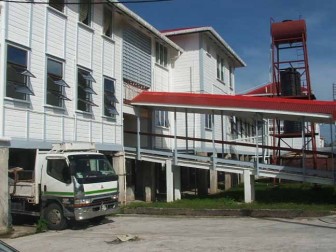The Region Three administration yesterday said that the West Demerara Regional Hospital (WDRH) has been undergoing continuous rehabilitation, while saying recent reports on the conditions at the facility are misleading.
Regional Information Officer Jaidev Dudhnath, in a statement on behalf of the region yesterday, said “it is alarming that Stabroek News in its edition dated Saturday, March 12, 2011 attempted to mislead the public by stating that the West Demerara Regional Hospital is beset by water shortages, limited staff and buildings badly in need of rehabilitation.”

In recent weeks, nurses, patients and visitors at the WDRH have bemoaned the poor conditions of the facility. Nurses had said they were tired of a working environment which is an “occupational health and safety hazard” and they highlighted the situation after two nurses were attacked by dogs, which had made the compound their haven. They also complained to the hospital administration about the leaky roof of one of the buildings and rotted floorboards. More than 25 dogs and about four cats that plagued the facility have since been “put down.” Most of the complaints concerned the rear of the WDRH compound, where a three-storey building, which houses the Male Medical Ward and the Female Medical Ward, is located.
Acting Regional Executive Officer (REO) of Region Three Paul Ramrattan, according to Region Three statement, said that the Stabroek News article “is a deliberate attempt to besmirch the name of the regional administration.” Ramrattan said that the hospital is set to benefit from a three year plan (2010 – 2012) which was proposed in 2009. Late last year, the REO explained, the WDRH benefited from a $43 million project which “entailed the complete rehabilitation of the inpatient surgical block which houses the maternity ward, two surgical theatres, and the male and female surgical wards.”
Another $25 million project, according to Ramrattan, is to be undertaken shortly and will see the complete rehabilitation of the Male and Female Medical block. He pointed out that as a result of this project, equipment, patients, beds and other such items were moved between locations to allow for the commencement of works. A further $9 million, he said, will also be spent this year to rehabilitate the outpatient/accident and emergency department.
He also said there is no water shortage at the WDRH at the inpatient surgical block and with regards to staffing he said that “approval has been given to fill most of the existing vacancies.” The Regional Administration, the REO assured, is doing “all it can to enhance working conditions and health care delivery at all medical/health institutions across the region.”
It was not clear in the statement just how many existing vacancies there are to be filled at the WDRH. The REO could not be contacted for further comment yesterday.
Meanwhile, when Stabroek News contacted the Chairman of the Region Three Regional Democratic Council Julius Faerber, he declined to comment. Faerber said that the statement addressed the issues to which the Regional Administration wished to respond.
Late last week, the relative of a patient in the Female Surgical Ward told Stabroek News that the building suffers from early morning water shortages and she had described the general dilapidated and unhealthy conditions at the medical institutions.
The woman said that on Monday when she was last at the hospital there was water for about 10 minutes in the female surgical ward and after that there was none. “I visited my relative throughout that day and there was no water…the barrels they now have in which water would normally be stored were empty,” she explained.
Since the Stabroek News article was published on Saturday, the woman said a hallway which was dangerously lined with bits of odd furniture and other materials has been cleared. However, there have been no other changes.
Meanwhile, the hospital administrator has spoken with patients in the Female Surgical Ward. “My relative told me that the administrator was very concerned about the information leaking out to the media and told the nurses in the ward that they would have to screen visitors to ensure that they were carrying no cameras or any device that could take pictures,” the woman explained. It is ridiculous, the woman said, that the hospital administration would stoop to such levels “to hide the truth from the country.”
Minister of Health Leslie Ramsammy, other senior officials within the Ministry of Health, administrator of the WDRH Bharrat Persaud and other officials at the medical institution have been unavailable to comment.
Meanwhile, a Government Information Agency (GINA) statement yesterday reported that in a recent interview, Regional Health Officer (RHO) Ravindranauth Persaud, who also holds a key position at the WDRH, said that several attempts were made to address the issue of the stray dogs.
The hospital administration along with the Guyana Society for the Prevention of Cruelty to Animals had made earlier attempts, before the complaints by nurses, to deal with the dogs but there were some challenges. A team of veterinarians, GINA reported the RHO as saying, assisted with addressing the problems.
He further noted that work is currently being done on the hospital fence, which is being repaired in phases. The administration, nurses had said, promised to fix the hospital’s fence to prevent other animals from entering the compound but it was yet to be done.
The inpatient building, Persaud also told GINA, is slated for renovation in May.
In 2010, according to GINA, a $37 million contract was signed for the rehabilitation of the hospital. This was done under the three year plan to which the regional administration referred in its statement.




